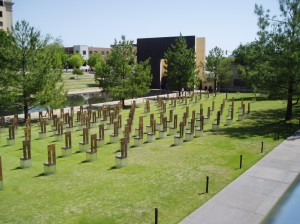 The Field of Empty Chairs, a reminder of each life lost. In the background, The Reflecting Pool to the right; Gate of Time to the left.
The Field of Empty Chairs, a reminder of each life lost. In the background, The Reflecting Pool to the right; Gate of Time to the left.
It was a normal Wednesday morning under a clear blue Oklahoma City sky on April 19, 1995. Workers made their way to offices, dropped off children at the building’s day-care center, perhaps poured themselves a cup of coffee to get a jump-start on their
day. Then, at 9:02, America’s innocence changed forever when the Alfred P. Murrah Federal Building was bombed, killing 168 people and injuring more than 500.
How could such a horrific thing happen on American soil? Timothy McVeigh, a former decorated United States Army soldier, claimed that the bombing was revenge for “what the U.S. government did at Waco and Ruby Ridge.” McVeigh and accomplice Terry Nichols, used readily available toxic industrial chemicals, ammonium nitrate, an agricultural fertilizer, and nitromethane, a highly volatile motor-racing fuel, to accomplish their despicable deed.
The attackers parked a rented Ryder truck in a loading area with a timer set to explode about 5,000 pounds of the highly combustible material. The explosion resulted in the worst terrorist attack on United States soil prior to the September 11, 2001 attacks. McVeigh was executed and accomplice Terry Nichols was sentenced to life in prison. A third party, Michael Fortier received a 12-year prison sentence plus a $200,000 fine for failure to warn authorities about the attack.
The blast tore away more than a third of the Murrah Building, but destroyed the entire building. In addition, fourteen buildings in the vicinity had to be torn down due to extensive destruction and another 312 buildings within a sixteen-block radius were damaged.
More than 12,000 people participated in relief and rescue work, including twenty-four canine units. Prompt investigation gave vital clues to the complexity of the crime and early leads on a suspect and accomplices led to extraordinarily quick arrests. Visitors watch news clips and special bulletins televised from around the world.
From April 20 to May 4, 1995 rescue and recovery operations poured into the area. Professional rescue workers, volunteers and canine units from all over the country clawed through the rubble to help dig out survivors and recover the dead. In the children’s day-care center directly above the mobile bomb, devastation was horrific. Upper floors collapsed onto those beneath them, crushing everyone and everything below.
Although the bombing of the Alfred P. Murrah Federal Building was born of hatred and violence, visiting the Oklahoma City National Memorial & Museum is an uplifting experience. Poignant sights and artifacts of the bombing are in plain view, but also evident is what this sacred ground has become: a monument of hope and faith, of remembrance of loved ones lost, of human spirits rising above this inhumane act.
Three distinct components comprise the memorial: the Outdoor Symbolic Memorial, dedicated on April 19, 2000, the fifth anniversary of the attack; the Memorial Museum, dedicated one year later, April 19, 2001; the Memorial Institute for the Prevention of Terrorism, a concept founded by families and survivors during the writing of the Mission Statement in 1995.
Wandering the grounds where the building once stood, visitors soon see that every exhibit is a vital symbol of this experience. One of the most poignant, the Field of Empty Chairs is a reminder of each life lost. The chairs, including nineteen smaller chairs representing the children who died, placed in nine rows, represent the nine floors of the building. Made of bronze, stone and glass, the chairs are placed in the row according to what floor the person was working or visiting when killed.
For more information, visit www.oklahomacitynationalmemorial.org or call 1-888-542-HOPE (4673).

